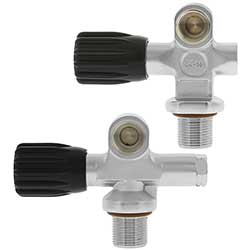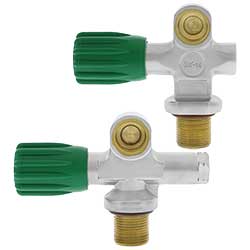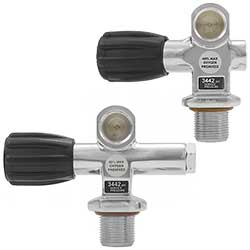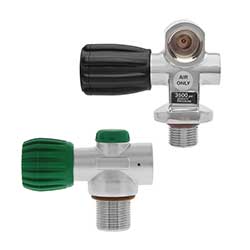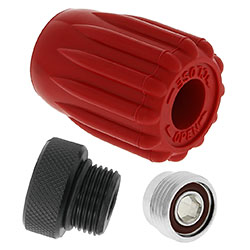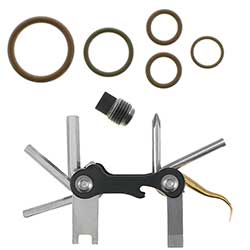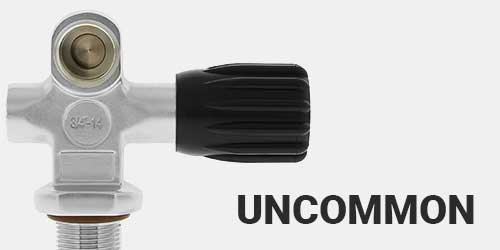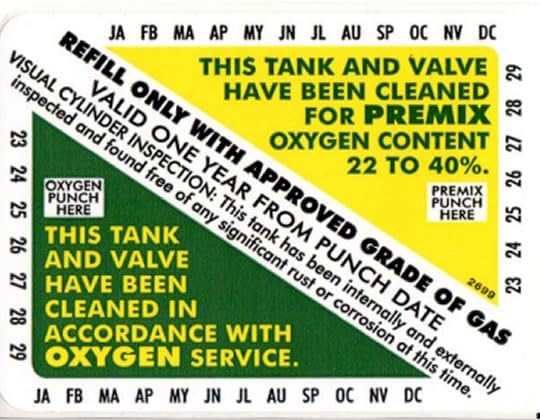Valves
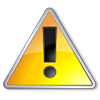 WARNING
WARNING
Installing Valves in SCUBA Cylinders (Torque Specifications)
Before installing the valve, any existing lubricant should be completely removed from both the cylinder threads and the valve threads using a clean lint-free cloth. Always place a new neck o-ring at the base of the valve inlet threads (an oxygen compatible neck o-ring is always included with our valves). Dive Gear Express currently does not recommend using any form of lubricant, even oxygen compatible lubricant, when installing our Nitrox Ready SCUBA valves in oxygen clean cylinders. For more information, please read Lubrication and SCUBA Valves.
For the DGX and Thermo brand scuba valves we offer, you may use the following torque values: The dip tube can be installed hand tight and snugged up with a hex key, about 40 inch-pounds, but do not over tighten or it will break off. The valve should be installed in the SCUBA cylinder with the least amount of force that will form a seal and retain the valve in place. Modern SCUBA valves that capture an o-ring in the cylinder neck can be installed by hand and snugged up with an open-end wrench across a flat at the base of the valve, about 50 foot-pounds. Take care to not over tighten the valve because it's the o-ring that makes the seal. Should the modular port plug or bonnet nut need to be replaced, it also can be hand tight and snugged up with an open-end wrench, about 30 foot-pounds.
To install the valve in the cylinder, screw the dip tube into the small inlet hole at the bottom of the valve and then screw the valve into the cylinder neck. Mate the threads using the click technique to avoid cross threading. The valve inlet threads should not bind and force is NOT required to fully screw the valve in to the cylinder neck. Snug the valve in to the neck, but do not use the wrench across the face of the valve and do not bang on the handwheel. An inspection should follow tightening the valve; be sure there is metal to metal contact all the around the base of the valve and the neck of the cylinder.
One important caution regarding thread compatibility; outside the United States, particularly in Europe, a widely used SCUBA cylinder neck thread form is M25. The 3/4 NPSM (ISO 228) imperial threads and M25 (BS 3643) metric threads are very similar but not identical; with the use of excessive force it's possible to mate diving cylinders and valves with these two different forms. However, the mismatched threads eventually separate with dangerously explosive force, often causing injury.
Note that port plugs used on the modular valve with the typical side handwheel are notched on the corners of the wrench flats. The notches indicate the screw threads are reversed, and must be rotated clockwise to remove and rotated counter-clockwise to install. This is the opposite of typical screw threads and attempting to remove the notched plug using counter-clockwise force will permanently damage the valve.
New scuba valves always include a properly installed over pressure relief device (PRD aka "burst disk") safety assembly. If the safety assembly is ever removed from the valve, the disk and gasket must be discarded because reusing a disk will also cause it to rupture prematurely. Should a safety assembly ever need to be replaced, install it using a socket torque wrench at 100 to 120 inch-pounds. Note that an inch-pound calibrated torque wrench must be used in order to assure proper function of the pressure relief device; too little torque will result in a leak or too much will result in premature rupture.
